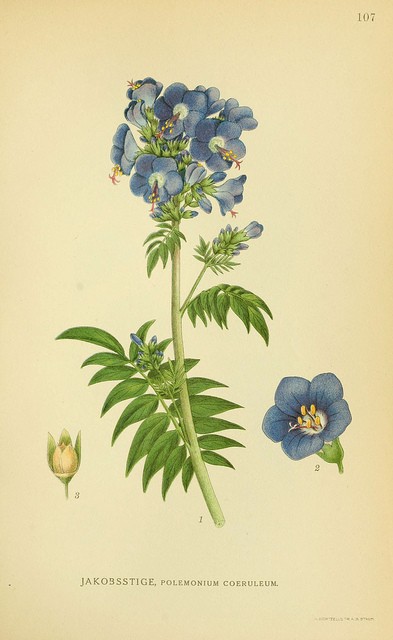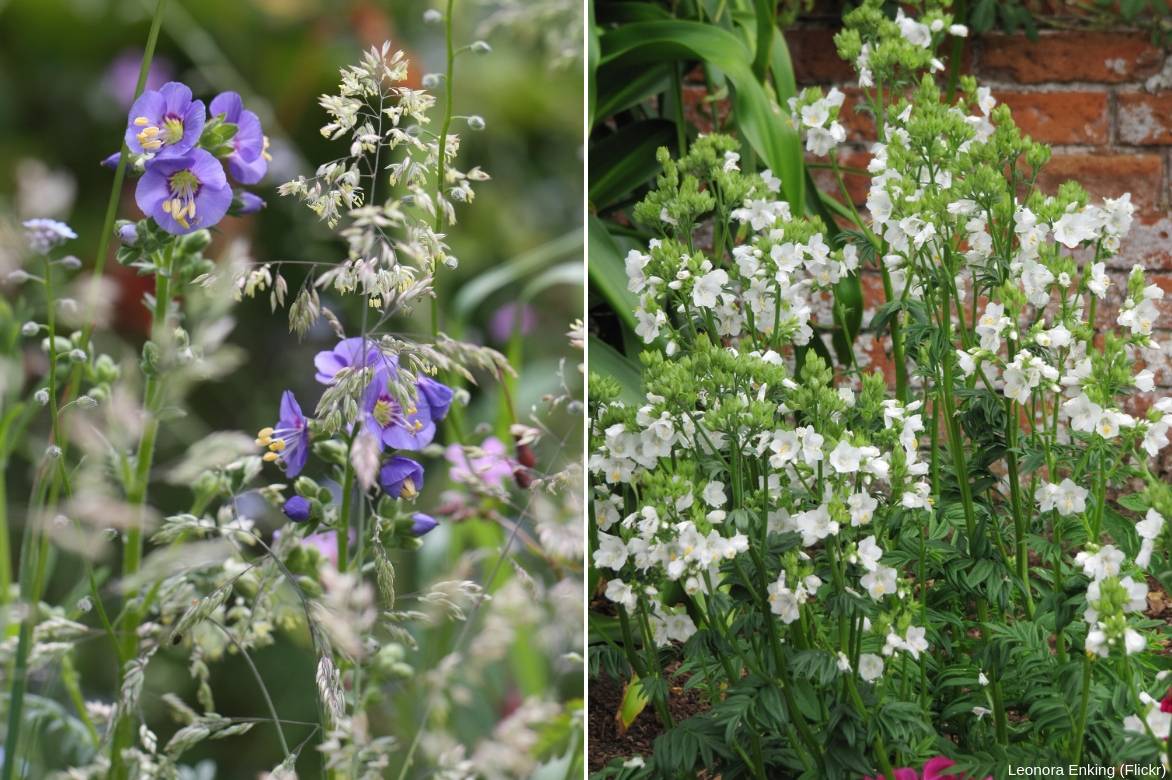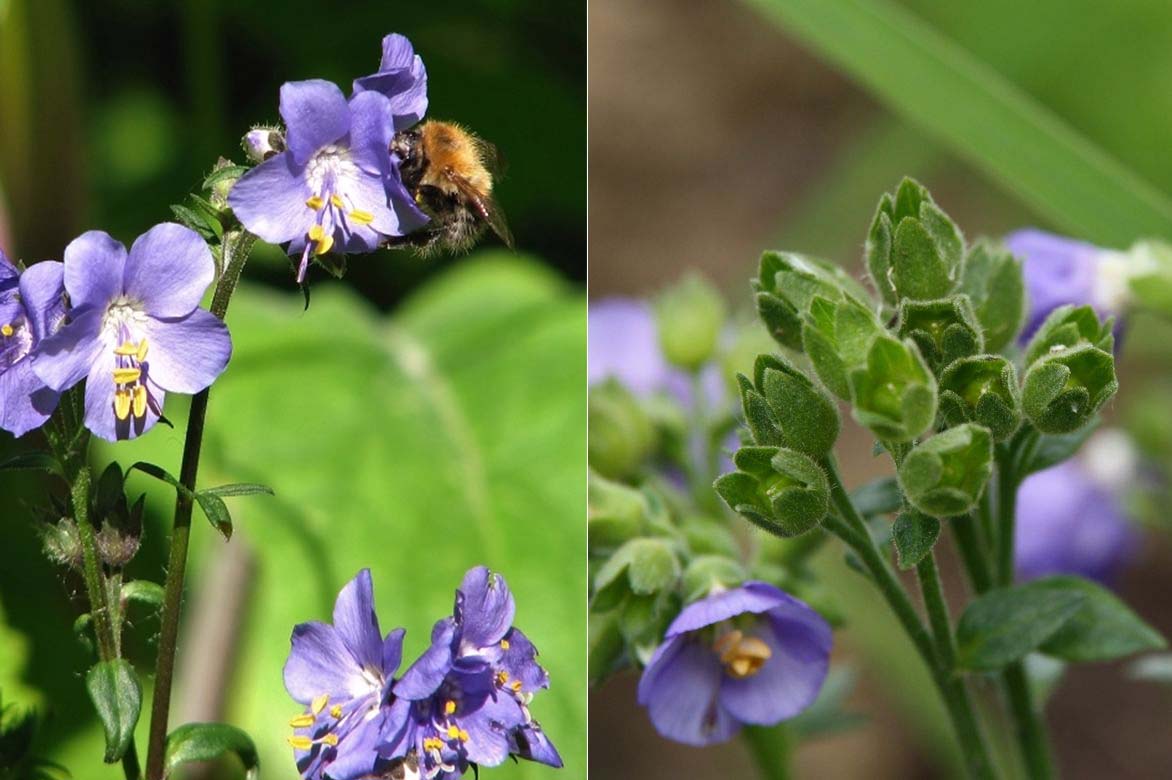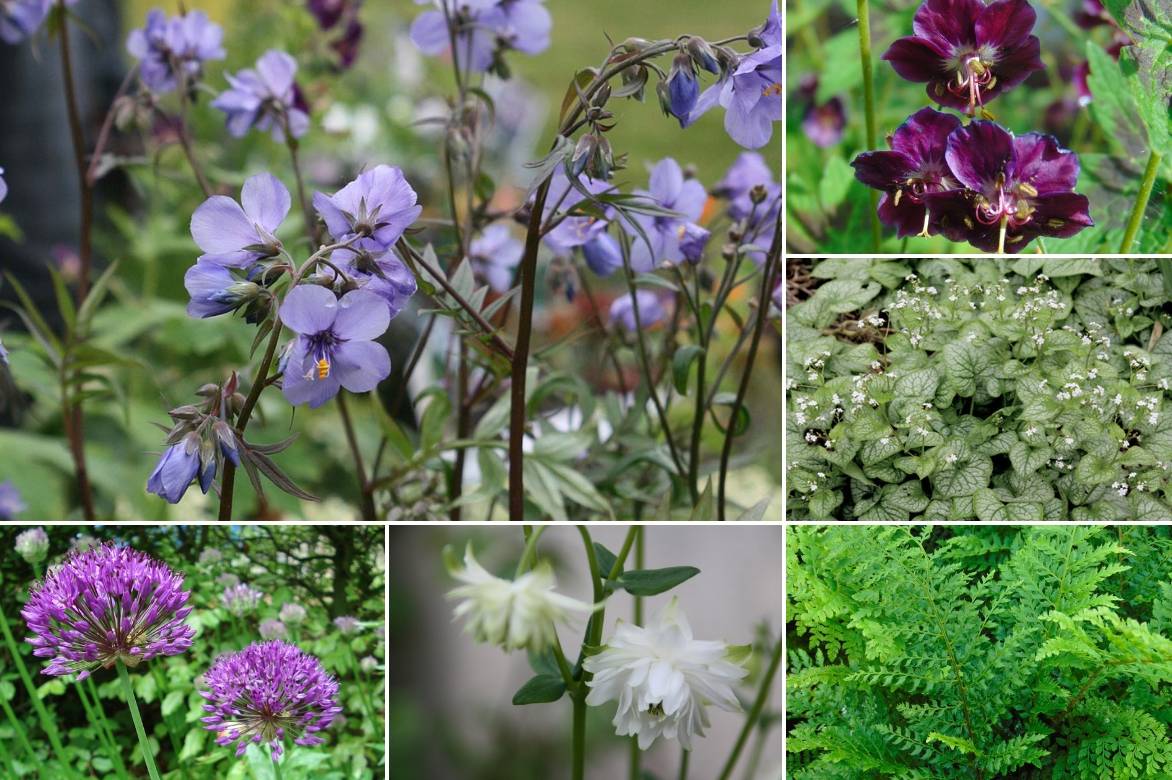
Polemonium: planting, growing and care
Contents
Polemonium, in a nutshell
- Polemonium, commonly called “Jacob’s ladder”, is a short-lived perennial that self-seeds freely.
- In spring it produces lush foliage resembling a dark green or variegated frond.
- Tall stems bearing cup-shaped flowers reminiscent of those of Geranium or Myosotis appear from spring to autumn.
- These plants are very easy to grow in fresh, well-drained soils, in sun or partial shade, and even in shade if you mainly want to enjoy the foliage.
A word from our expert
Polémonium, sometimes called polemonies, are somewhat forgotten plants formerly very common in our grandmothers’ gardens for their splendid arched foliage reminiscent of ferns. Luxuriant finely divided leaves in glossy dark green tones, sometimes attractively variegated with cream or pale pink, their ease of cultivation, excellent hardiness and spontaneous sowing have undoubtedly contributed to their success. They also benefit from a long flowering in blue, violet, white or pale pink which provides lovely brightness to woodland edges or shaded banks.
Flowering of Polémonium stretches over about two months, beginning with late tulips, peonies and Oriental poppies, with which Polemonium coeruleum harmonises beautifully. The airy flowering also complements old-fashioned roses gracefully. Cultivar ‘Brise d’Anjou’, selected by Pépinières Prouteau for its distinctive foliage streaked with cream, also produces a later flowering from August to October of deep violet-blue, while Polemonium reptans flowers in May–June, studding matt green foliage with dense heads of lavender-blue or white flowers.
Polemonies make very pretty bedding plants, often used as borders, but equally at home in a rock garden even on slightly calcareous soil. They prefer rich, clayey, cool soils as well as drained humus-bearing soils. Groundcover species such as Polemonium pulcherrimum and carneum can cover a trough or a sunny to semi-shaded rock garden. Some species readily self-seed if spent flowers are left.
Description and botany
Botanical data
- Latin name Polemonium
- Family Polemoniaceae
- Common name Jacob's Ladder, Greek valerian, Polemonium
- Flowering between May and October
- Height between 0.25 and 0.70 m
- Sun exposure sun or part shade
- Soil type any fresh well-drained soil, light humus-bearing or rocky
- Hardiness Excellent (-30 to -20 °C)
Les Polemonium are perennials or annuals belonging to family Polemoniaceae and comprise 38 species. They occur across temperate regions of northern hemisphere and the Arctic.
Polemonium caeruleum, called Greek valerian, is the only species encountered in France in the wild where it is protected. This montane species occupies woods and damp pastures of high mountains up to 2000 m altitude in Jura, Savoie, Haute-Loire, Puy-de-Dôme, Cantal and central Pyrenees but extends to central and northern Europe, the Caucasus, Siberia and North America. Its origins explain very good adaptation to cold, humid climates. It hates humid heat. This species forms a rosette of dense leaves topped by several rigid, blue-violet flower stems measuring 30 to 80 cm, sometimes 120 cm, in height. It has given rise to cultivars with white flowers, large flowers up to 2 cm wide such as ‘Lambrook Mauve’, cream-margined leaves such as ‘Brise d’Anjou’…
Fern-like foliage characteristic of Polemoniums shows dozens of small pointed leaflets, inserted perpendicular to the central vein like rungs of a ladder (hence common name Jacob’s Ladder) and occurring in odd numbers (odd-pinnate).

Polemonium caeruleum – botanical illustration
The alternate leaves with a petiole form a lush mass at the base while they dress the flowering stems in a more scattered, discreet way.
The flower stems are hollow and ridged, bearing at their tip a panicle of delicate flowers of a pretty blue-violet from spring to late summer which contrasts with the intense green of the foliage. The corolla, surrounded by a green calyx with 5 villous, glandulous lobes, has a short tube ending in 5 blunt ovate lobes forming a cup 0.8 to 1.5 cm wide. Flower centre tinged with golden yellow is crowned by 5 pale yellow stamens turning golden at ripeness and a long white pistil ending in 3 points. The genus offers a surprising diversity of flowerings such as the orange tubular corollas of P. pauciflorum, the large pale-blue bells of Polemonium Stairway to Heaven or the intense blue of P. caeruleum Sapphire, the funnel-shaped pale-pink flowers of Polemonium carneum Apricot Delight…
Slightly scented flowering attracts bees and butterflies, eager for pollen.
Fruits are three-angled capsules containing 4 to 6 seeds in each of the three chambers.
Cut flowers of Greek valerian keep well in a vase; the variety Sonia’s Bluebell is particularly suited to this use as it flowers from May to August.
In former times in eastern United States, dried roots of Polemonium reptans were used in herbal medicine. They were harvested in autumn, then dried for later use.

Some Polemoniums : P. caeruleum ‘Bressingham Purple’, P. reptans ‘Blue Pearl’, Polemonium ‘Lambrook Mauve’, P. carneum ‘Apricot Delight’ and the pretty variegated foliage of P. reptans ‘Touch of Class’
Main varieties of Polemonium

Polemonium caeruleum Lambrook Mauve
- Flowering time July to September
- Height at maturity 40 cm

Polemonium reptans Touch of Class
- Flowering time June, July
- Height at maturity 40 cm

Polemonium carneum Apricot Delight
- Flowering time June to September
- Height at maturity 40 cm

Polemonium Sonia's Bluebell
- Flowering time June to August
- Height at maturity 50 cm

Polemonium yezoense Purple Rain
- Flowering time July to October
- Height at maturity 50 cm

Polemonium caeruleum Brise d'Anjon
- Flowering time June to September
- Height at maturity 50 cm
Discover other Polemonium - Jacob's Ladder
View all →Available in 1 sizes
Available in 0 sizes
Available in 1 sizes
Available in 1 sizes
Available in 1 sizes
Available in 1 sizes
Available in 1 sizes
Available in 1 sizes
Available in 2 sizes
Available in 1 sizes
Planting
Where to plant Polemonium?
Polemoniums are easy to grow and are planted in any soil that stays cool in summer but drains well. They appreciate soils rich in humus. Avoid, however, soils that are too acidic or too calcareous.
Choose a position that is not too scorching in sun or a semi-shaded spot. Planting in shade produces few flowers but remains interesting for the aesthetic of the deeply divided glossy dark green foliage, variegated with cream or purple.
Avoid the combination of intense heat and humidity in regions with hot summers. Foliage is sensitive to scorching sun rays so this plant is best favoured in regions with cool summers.
Polemoniums are very hardy and can withstand cold down to -20 to -30°C depending on species.

When to plant?
Polemoniums are best planted in autumn to encourage good establishment before summer.
How to plant?
This plant is easy to grow.
- Soak buckets in a bucket of water.
- Work the plot with a digging fork to loosen soil deeply.
- Position young plants about 50 cm apart.
- Dig a hole the size of the root ball with a small trowel.
- If soil is very clayey, add a spadeful of compost per hole or plant on a mound to ensure good drainage.
- Remove bucket and tease out any circling roots if necessary.
- Plant the root ball taking care not to bury the collar and firm lightly.
- Water then mulch.
Polemonium can be grown in large pots of at least 18 cm diameter. Fill container, pierced at base, with a mixture of potting compost and coarse sand.
Caring for Polemonium
Care is simple and summarised in a few steps :
- Keep soil moist even in summer.
- To encourage flowering and improve foliage retention, cut back some faded inflorescences. Leave some seedheads to ensure renewal of plants that have a fairly short lifespan.
- If plant tends to spread too much, remove seedheads.
- Polemonium does not need dividing and does not tolerate transplanting well.
- Fertilisation is unnecessary.
Multiplication
Easiest propagation is to divide clump in spring or autumn, but polemoniums can also be obtained by propagation by cuttings of young spring shoots or by sowing in autumn or under cover in February–March.
Polemoniums are generous: they tend to self-seed abundantly yet never become invasive. They are then very easy to transplant.

Clump division
Proceed when foliage is barely developed in late winter or in autumn before it dies back :
- Using spade, separate rosettes with as many roots as possible.
- Replant immediately in light soil, without burying collar.
Propagation by cuttings
Prepare a deep pot by filling it with potting compost mixed with sand or prepare a patch of soil protected by a cold frame ;
- Take shoot tips about 10 cm long.
- Remove leaves from near base of cutting.
- Insert these to two-thirds of their length, leaving enough space between them for development until following spring.
- Firm soil gently all around to remove air pockets and ensure good contact between potting compost and cutting.
- Place them under cold frame in shade.
- In following spring, separate rooted cuttings and plant directly in place.
Sowing
- Harvest Polemonium seeds in June or July by opening capsules.
- If sowing in spring, place seeds in refrigerator for a few weeks before sowing.
- Sow in seed tray filled with seed compost, covering seeds lightly.
- Water gently and place in heated room. Germination occurs in 10 to 14 days.
- Prick out seedlings into buckets when possible to handle them.
- Pinch stems when strong enough to encourage ramification.
- Plant in autumn if clump has become well established or wait until following year.
Uses and associations
Greek valerian is a border plant well suited to mixed borders to add airiness alongside other perennials or to flower at base of roses. Show it in a border of blue–pink–white tones or in contrast with a complementary shade such as orange. Its flowering coincides with late tulips, Oriental poppies, peonies, Potentilla fruticosa ‘Hopleys Orange’, as well as globeflowers, aquilegias, daylilies and geums, which also prefer moist soils.

An idea for a partial-shade combination: Polemonium caeruleum ‘Bressingham Purple’, Geranium phaeum ‘Samobor’, Brunnera macrophylla ‘Mr Morse’, Polystichum setiferum ‘Proliferum’, Aquilegia ‘Green Apples’ (‘White Barlow’ would also suit), Allium aflatunense ‘Purple Sensation’
Play with foliage combinations by mixing large leaves of Hostas, Siberian forget-me-nots, fronds of ferns and the dentate, richly coloured leaves of Heucheras, within a wooded garden or a semi-shaded rockery.
Accentuate shaded path edges with a bed of Greek valerian which, with its larkspur-like habit, provides attractive groundcover and generous flowering.
You can also position prominently a specimen such as Polemonium yezoense ‘Purple Rain’, whose purple foliage remains decorative for long, in a deep container to serve as a focal point.

An example of a combination: Polemonium and knotweed (here, Polygonum alpinum) make a good pairing (astilbes such as ‘Sprite’ or ‘Hennie Graafland’ would also work well) !
Within a rockery or at an edge, the spreading forms of Polemonium reptans can mingle with bells of pasque flowers richly tinted violet or carmine red or with white spring anemones (Anemone sylvestris…). The variety ‘Touch of Class’, with very soft green–grey foliage, finely margined with white, prefers semi-shaded to shaded spots such as an understorey, a courtyard or a shaded garden. It pairs wonderfully with blue Corydalis, bleeding hearts, Geranium nodosum or Epimediums. It is also a good plant to decorate edges of water features and very useful in naturalistic gardens for attracting pollinating insects.
Useful resources
Discover our range of Polemonium.
- Subscribe!
- Contents










































Comments